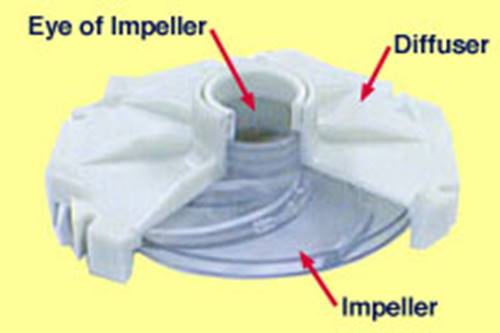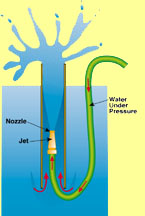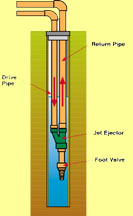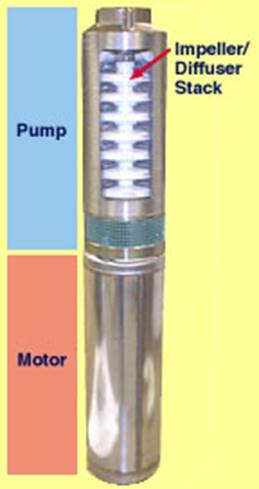PUMP BASICS
How Centrifugal Pump
A centrifugal pump is of very simple design. The only moving part is an impeller attached to a shaft that is driven by the motor.
The two main parts of the pump are the impeller and diffuser.
The impeller can be made of bronze, stainless steel, cast iron, polycarbonate, and a variety of other materials. A diffuser or volute houses the impeller and captures the water off the impeller.
Water enters the eye of the impeller and is thrown out by centrifugal force. As water leaves the eye of the impeller a low pressure area is created causing more liquid to flow toward the inlet because of atmospheric pressure and centrifugal force. Velocity is developed as the liquid flows through the impeller while it is turning at high speeds on the shaft. The liquid velocity is collected by the diffuser or volute and converted to pressure by specially designed passageways that direct the flow to discharge into the piping system; or, on to another impeller stage for further increasing of pressure.

The head or pressure that a pump will develop is in direct relation to the impeller diameter, the number of impellers, the eye or inlet opening size, and how much velocity is developed from the speed of the shaft rotation. Capacity is determined by the exit width of the impeller. All of the these factors affect the horsepower size of the motor to be used; the more water to be pumped or pressure to be developed, the more energy is needed.
A centrifugal pump is not positive acting. As the depth to water increases, it pumps less and less water. Also, when it pumps against increasing pressure it pumps less water. For these reasons it is important to select a centrifugal pump that is designed to do a particular pumping job. For higher pressures or greater lifts, two or more impellers are commonly used; or, a jet ejector is added to assist the impellers in raising the pressure.
JET PUMPS
Jet Pumps are mounted above ground and lift the water out of the ground through a suction pipe. Jets are popular in areas with high water tables and warmer climates. There are two categories of jet pumps and pump selection varies depending on water level. Shallow well installations go down to a water depth of about 25 feet. Deep wells are down 150 feet to water, where surface pumps are involved.
The jet pump is a centrifugal pump with one or more impeller and diffuser with the addition of a jet ejector. A JET EJECTOR consists of a matched nozzle and venturi. The nozzle receives water at high pressure. As the water passes through the jet, water speed (velocity) is greatly increased, but the pressure drops. This action is the same as the squirting action you get with a garden hose as when you start to close the nozzle. The greatly increased water speed plus the low pressure around the nozzle tip, is what causes suction to develop around the jet nozzle. Water around a jet nozzle is drawn into the water stream and carried along with it.
  |
For a jet nozzle to be effective it must be combined with a venturi. The venturi changes the high-speed jet stream back to a high-pressure for delivery to the centrifugal pump. The jet and venturi are simple in appearance but they have to be well engineered and carefully matched to be efficient for various pumping conditions. The jet nozzle and venturi are also known as ejectors/ejector kits. |
A portion of the suction water is recirculated through the ejector with the rest going to the pressure tank. With the ejector located on the suction side of the pump, the suction is increased considerably. This enables a centrifugal pump to increase its effective suction lift from about 20 feet to as much as 28 feet. But, the amount of water delivered to the storage tank becomes less as the distance from the pump to the water increases... more water has to be recirculated to operate the ejector.
The difference between a deep-well jet pump and a shallow-well jet pump is the location of the ejector. The deep-well ejector is located in the well below the water level. The deep-well ejector works in the same way as the shallow-well ejector. Water is supplied to it under pressure from the pump. The ejector then returns the water plus an additional supply from the well, to a level where the centrifugal pump can lift it the rest of the way by suction.
|
A convertible jet pump allows for shallow-well operation with the ejector mounted on the end of the pump body. This type of pump can be converted to a deep-well jet pump by installing the ejector below the water level. This is of particular value when you have a water level that is gradually lowering. This will probably require a change of venturi to work efficiently. Because jet pumps are centrifugal pumps, the air handling characteristics are such that the pump should be started with the pump and piping connections to the water supply completely filled with water. |
With a shallow-well jet pump, the ejector is mounted close to the pump impeller. With a deep well jet pump, the ejector is usually mounted just above the water level in the well, or else submerged below water level.
Centrifugal pumps, both the shallow-well and deep well types have little or no ability to pump air. When starting, the pump and suction line needs to have all of the air removed. An air leak in the suction line will cause the pump to quit pumping ... or sometimes referred to as "losing its prime".
SUBMERSIBLE PUMP

|
The submersible pump is a centrifugal pump. Because all stages of the pump end (wet end) and the motor are joined and submerged in the water, it has a great advantage over other centrifugal pumps. There is no need to recirculate or generate drive water as with jet pumps, therefore, most of its energy goes toward "pushing" the water rather than fighting gravity and atmospheric pressure to draw water. |
The pump and motor assembly are lowered into the well by connecting piping to a position below the water level. In this way the pump is always filled with water (primed) and ready to pump. Because the motor and pump are under water they operate more quietly than above ground installations; and, pump freezing is not a concern.
We can stack as many impellers as we need; however, we are limited to the horsepower of the motor. We can have numerous pumps that have 1/2 HP ratings - pumps that are capable of pumping different flows at different pumping levels; they will, however, always be limited to 1/2 HP. Another way to look at it is that a pump will always operate somewhere along its design curve.
To get more flow, the exit width of the impeller is increased and there will then be less pressure (or head) that the pump will develop because there will be less impellers on a given HP size pump. Remember, the pump will always trade-off one for the other depending on the demand of the system. If the system demands more than a particular pump can produce, it will be necessary to go up in horsepower; thereby, allowing us to stack more impellers or go to different design pump with wider impellers.
Source: https://msu.edu/course/tsm/431/PUMP%20BASICS.doc
Web site to visit: https://msu.edu
Author of the text: indicated on the source document of the above text
If you are the author of the text above and you not agree to share your knowledge for teaching, research, scholarship (for fair use as indicated in the United States copyrigh low) please send us an e-mail and we will remove your text quickly. Fair use is a limitation and exception to the exclusive right granted by copyright law to the author of a creative work. In United States copyright law, fair use is a doctrine that permits limited use of copyrighted material without acquiring permission from the rights holders. Examples of fair use include commentary, search engines, criticism, news reporting, research, teaching, library archiving and scholarship. It provides for the legal, unlicensed citation or incorporation of copyrighted material in another author's work under a four-factor balancing test. (source: http://en.wikipedia.org/wiki/Fair_use)
The information of medicine and health contained in the site are of a general nature and purpose which is purely informative and for this reason may not replace in any case, the council of a doctor or a qualified entity legally to the profession.
The texts are the property of their respective authors and we thank them for giving us the opportunity to share for free to students, teachers and users of the Web their texts will used only for illustrative educational and scientific purposes only.
All the information in our site are given for nonprofit educational purposes